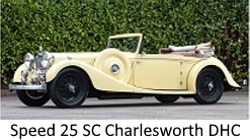Speed 25 Description
The Speed 25 model was developed to replace the highly acclaimed Speed 20 which had built up a fine reputation since its introduction in 1932. Designed around the Speed 20 chassis the new model was fitted with the new 25.63 HP six cylinder 3 ½ litre engine introduced in 1935 (designated as SA 25.63) with a bore and stroke of 83 x 110mm (Speed 20 was 73 x 110mm). The crankshaft was carried in 7 main bearings and fitted with a vibration damper instead of the 4 bearing unit of the Speed 20. The air intake for the triple SU carburettors incorporated an air silencer. Fuel tank capacity increased to 17 gallons.
Alternative final drive ratios of 4.11:1 and 4.33:1replaced those of 4.55:1 and 4.77:1 of the Speed 20. Luvax shock absorbers with fingertip control replaced the Andre Telecontrol system. Exceptionally long 57 inch rear springs were used on the new car on the same length chassis (10 feet 4 inch wheelbase) as the Speed 20 which had 48 inch rear springs, while the same lengthening effect was achieved at the front by reducing the size of the central mounting bracket of the transverse spring.
The 1936 SB25.63 (Speed 25) was available in chassis form (priced at £600) and with several coachbuilt bodies – an open four seater sports at £700, a drophead-coupe and a saloon at £850. Charlesworth was the main coachbuilder of all these styles but Cross & Ellis built several tourers. Vanden Plas, Offord and Lancefield all produced at least one version.
The model maintained the characteristic low bonnet line and dashing appearance of the Speed 20 yet adopted the slightly higher roof line of the 3 ½ litre model of 1935. A new style radiator grill employed vertical slats instead of the earlier wire mesh, and a pair of splendid P100 headlamps gave the finishing touch. The combined effect of all these features gave the Speed 25 a most dignified appearance and firmly established it as one of the aristocrats of the prewar motoring world.
Inside, a new styled facia allowed the gear lever to be lengthened with resulting lighter control. A large tachometer faces the driver while a matching speedometer faces the passenger. The ignition switch was moved to a central position and pneumatic cushions were fitted to all seats.
The same models continued through 1937 with some improvements in the autumn of 1937 for the 1938 model SC series cars and price increases of £25 for the chassis and £35 for the complete cars. The front chassis was boxed in and stiffened up on many but apparently not all models while a Clayton-Dewandre vacuum servo was added to the braking system. Ignition was by coil only. The fuel supply and pumps were moved to the cool off-side of the chassis so that they were as far away as possible from the exhaust system.
From the 1939 model year, saloons were fitted with double sliding roofs and with the other models had running boards replaced by valances from the front wings. Mechanical changes included altered cam profiles, dual exhaust manifolds each with three expansion chambers to make the car even quicker. Tank capacity increased to 19 gallons. Electric gauges on the dash showed sump contents at the pressof a button and the trafficator switch moved to an outrigger on the steering column. Prices remained unchanged.
Minor changes followed for the final 1940 model year. Performance was improved by increasing the compression ratio. Engine location was made more positive by the addition of two adjustable tie-rods from the chassis to the rear of the power unit.
Contemporary reports were full of praise – Sir Malcolm Campbell tested a saloon in 1937, remarking that the car handled perfectly in traffic as well as in open country. After passing the 30mph limit on the way to Brooklands every other car was left behind. The steering was light and there was no engine vibration. He concluded that the car behaved like a true thoroughbred. Another road test summed up the Speed 25 as providing exceptional capacity and high speed combined with quiet running and very satisfactory certainty of control. The “Autocar” road test of June 1938 remarked on its handsome appearance and excellent finish down to the last detail and said that on the road it was an outstanding machine at well below the £1000 mark. “This is so obviously a fast car designed as a fast car, not one that happens to have sufficient engine power to make it go quickly without the chassis being entirely in keeping. The manner in which it recorded well above 95mph on the Brooklands track was a masterpiece of mechanical ease”.
The 391 Speed 25 chassis built were manufactured in batches:
SB 13326-13385 60
SC 13656-13695 40
SC 14346-14495 150
SC 14549-14689 141
It is believed that a further batch of chassis with numbers 14690 to 14798 were underway but all were destroyed during the night of `14th November 1940 when the Alvis factory was destroyed by enemy bombing of Coventry.
Speed 25 The SB and SC

The SB speed 25 underwent quite a few continuously developing technical improvements and after a year or so the SC speed 25 was "declared" and this was also subject to continuous technical improvements during the next few years right up until the factory was bombed in 1940. There is no absolute build standard that separates the SB from the SC although there are some significant technical changes that appear to coincide with the declaration of the SC.

In a similar way, the available styles of coachwork evolved and some styles would have been fitted to both SB and SC chassis. There are some bodywork styles which are clearly early in the speed 25 lifecycle and others that are clearly later, but this is a time based function, not anything to do with the SB or SC chassis designation.